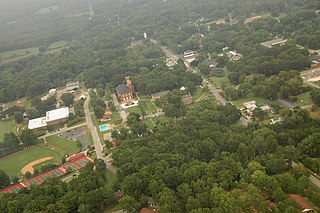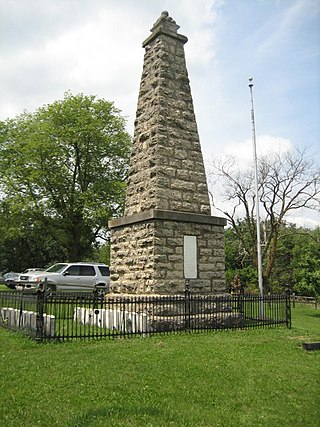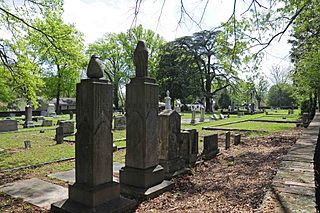
Due West is a town in Abbeville County, South Carolina, United States. The population was 1,247 at the 2010 census. It is the home of Erskine College and Dixie High School.

Mebane is a city located mostly in Alamance County, North Carolina, United States, and partly in Orange County. The town was named for Alexander Mebane, an American Revolutionary War general and member of the U.S. Congress. It was incorporated as "Mebanesville" in 1881, and in 1883 the name was changed to "Mebane". It was incorporated as a city in 1987. The population as of the 2020 census was 17,768. Mebane is one of the fastest-growing municipalities in North Carolina. Mebane straddles the Research Triangle and Piedmont Triad Regions of North Carolina. The bulk of the city is in Alamance County, which comprises the Burlington Metropolitan Statistical Area, itself a component of the Greensboro-Winston-Salem-High Point Combined Statistical Area. Two slivers in the eastern portion of the city are in Orange County, which is part of the Durham-Chapel Hill Metropolitan Statistical Area, itself a component of the Raleigh-Durham-Chapel Hill Combined Statistical Area.

The Sydney Town Hall is a late 19th-century heritage-listed town hall building in the city of Sydney, the capital city of New South Wales, Australia, housing the chambers of the Lord Mayor of Sydney, council offices, and venues for meetings and functions. It is located at 483 George Street, in the Sydney central business district opposite the Queen Victoria Building and alongside St Andrew's Cathedral. Sited above the Town Hall station and between the city shopping and entertainment precincts, the steps of the Town Hall are a popular meeting place.

Grafton National Cemetery is a United States National Cemetery located in Grafton, West Virginia. It encompasses a total of 3.2 acres (1.3 ha). Along with West Virginia National Cemetery, it is one of two United States Department of Veterans Affairs national cemeteries in West Virginia, both of which are located in Grafton. The first interments took place in 1867 for casualties of the American Civil War in West Virginia.

Salisbury National Cemetery is a United States National Cemetery located in the city of Salisbury, in Rowan County, North Carolina. It was established at the site of burials of Union soldiers who died during the American Civil War while held at a Confederate prisoner of war camp at the site.
Ninety Six National Historic Site, also known as Old Ninety Six and Star Fort, is a United States National Historic Site located about 60 miles south of Greenville, South Carolina. The historic site was listed on the National Register in 1969, declared to be a National Historic Landmark in 1973, and established as a National Historic Site in 1976 to preserve the original site of Ninety Six, South Carolina, a small town established in the early 18th century. It encompasses 1,022 acres of property.

Lone Fir Cemetery in the southeast section of Portland, Oregon, United States is a cemetery owned and maintained by Metro, a regional government entity. Listed on the National Register of Historic Places, the first burial was in 1846 with the cemetery established in 1855. Lone Fir has over 25,000 burials spread over more than 30 acres (120,000 m2).

Kellogg's Grove is an area in western Stephenson County, Illinois, United States near the present-day unincorporated town of Kent. The grove is considered historically significant because it was the site of two minor skirmishes during the Black Hawk War in 1832. Today, most of the grove is privately owned but 1.5 acres (6,100 m2) are allocated as a park owned by Stephenson County. While most of the battle occurred on what is today private property the park contains a monument dedicated to the battle and cemetery with the graves of several militia members killed during the skirmish at Kellogg's Grove. The cemetery also holds the graves of those killed in other area battles. The Kellogg's Grove battle site was added to the U.S. National Register of Historic Places in 1978.

West Laurel Hill Cemetery is a historic rural cemetery located in Bala Cynwyd, Pennsylvania. It was founded in 1869, is 200 acres in size and contains the burials of many notable people. It is affiliated with Laurel Hill Cemetery in neighboring Philadelphia. The cemetery property is an accredited arboretum and has an on-site funeral home and crematorium. The cemetery contains two Jewish burial sections and an environmentally friendly burial section. The cemetery was listed on the National Register of Historic Places in 1992.

Magnolia Cemetery is a 10-acre (4.0 ha) cemetery in Baton Rouge, Louisiana.
Singleton's Graveyard is an historic plantation cemetery located off SC 261 in the High Hills of Santee, 6 miles south of Wedgefield, South Carolina. On May 13, 1976, it was added to the National Register of Historic Places.

Strawberry Chapel is a parochial chapel of ease in the lower part of St. John's, Berkeley Parish in Berkeley County, South Carolina that was built in 1725. It is on Strawberry Chapel Road between South Carolina State Highway 8-44 and the West Branch of the Cooper River. Bordering Strawberry's property is the South Carolina State owned historic site of the “Town of Childsbury.” It was a planned community that was settled in 1707. The town no longer exists. They were named to the National Register of Historic Places on April 26, 1972.

Magnolia Cemetery is a historic rural cemetery in Charleston, South Carolina. The first board for the cemetery was assembled in 1849 with Edward C. Jones as the architect. It was dedicated in 1850; Charles Fraser delivered the dedication address. It was listed on the National Register of Historic Places as a Historic District in 1978.

Old Greenwood Cemetery is a historic cemetery located at Greenwood, Greenwood County, South Carolina. Established around the year 1860, the Old Greenwood Cemetery is a historic burial place in the said city. It is significant because of being the oldest cemetery in the area. This being said, it has also become the resting place for many prominent figures in the locale.

Mount Zion African Methodist Episcopal Church and Mount Zion Cemetery is a historic church and cemetery located at 172 Garwin Road in Woolwich Township, New Jersey, United States. The church was a stop on the Greenwich Line of the Underground Railroad through South Jersey operated by Harriet Tubman for 10 years. The church provided supplies and shelter to runaway slaves on their way to Canada from the South. The church and cemetery were part of the early 19th-century free negro settlement sponsored by Quakers known as Small Gloucester.

All Saints Church Pawleys Island is a historic church complex and national historic district located on Pawleys Island, Georgetown County, South Carolina. The district encompasses three contributing buildings and one contributing site—the sanctuary, cemetery, rectory, and chapel. In 2004, it left the Episcopal Church to join the Diocese of the Carolinas, now part of the Anglican Church in North America, a denomination within the Anglican realignment movement.

The Cane Hill Cemetery is a cemetery in Canehill, Arkansas. It is located just south of Washington County Route 13 and west of Arkansas Highway 45.

Rivers Bridge State Historic Site, also known as Rivers Bridge State Park, located near Ehrhardt, a small town in Bamberg County, South Carolina, is the site of an important Civil War battle. It is in this area that General William T. Sherman engaged the Confederate Army on his advance from Savannah, and after two days of battle, outflanked the Confederates and forced them to withdraw. River Bridge State Park was listed in the National Register of Historic Places on February 23, 1972.

Halifax Historic District is a national historic district located at Halifax, Halifax County, North Carolina, US that was listed on the National Register of Historic Places in 1970. It includes several buildings that are individually listed on the National Register. Halifax was the site of the signing of the Halifax Resolves on April 12, 1776, a set of resolutions of the North Carolina Provincial Congress which led to the United States Declaration of Independence gaining the support of North Carolina's delegates to the Second Continental Congress in that year.

Shiloh Presbyterian Church Cemetery is a historic Presbyterian cemetery located near Grover, in Cleveland County, North Carolina and Cherokee County, South Carolina. It was established in 1780 in conjunction with the construction of the Shiloh Meeting House. Revolutionary War hero William Patterson, who died on October 5, 1780, the day of the Battle of Kings Mountain, and was the first person interred at the cemetery. The cemetery is the oldest burying ground in the southeast section of Cleveland County, North Carolina. It includes a number of notable gravestones carved from greenish schist and soapstone dating from 1780s to the 1820s. The cemetery includes 104 gravestones in the North Carolina section of the property, and four gravestones in the South Carolina section.






















